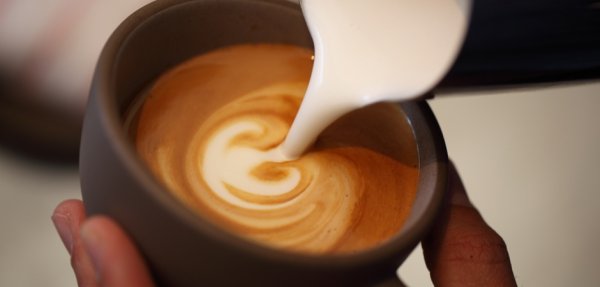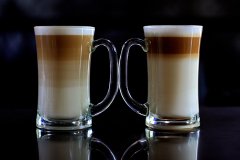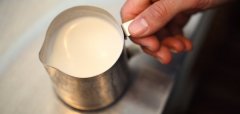The knowledge of hand-beating milk foam what is the production of hand-cold milk foam Italian coffee with beans
Coffee is a beverage made from roasted coffee beans, which is the main drink popular in the world along with cocoa and tea.
Coffee tree is a small evergreen tree of Rubiaceae. Coffee for daily consumption is made from coffee beans combined with various cooking utensils, and coffee beans refer to the nuts in the fruit of coffee trees, which are then baked in an appropriate way. The taste of a standard cup of coffee should not be bitter, and a qualified barista will strictly carry out every step when making coffee. Finally, the coffee presented to the guests will show varying degrees of sweetness, acidity, mellow thickness or cleanliness in the taste.
Knowledge of making milk foam by hand
What is milk foam?
These concepts are the concepts in my teaching system, but can not be treated as industry standard concepts, remember! Hot milk: refers to the milk that has not been sent at the bottom of the flower jar after the foam operation; foam refers to the foam floating on the upper part of the hot milk after the foam operation; the foam refers to the final product formed after the hot milk and foam are fully mixed after the foam operation. This is also the purpose of milking in most cases.
The method of making milk foam by hand
The first step: first do fast low hit, hit until there is obvious resistance and continuous feeling; then do medium hit, also hit obvious resistance and continuous feeling; finally do high hit, hit as a whole have resistance and continuous feeling. Tip: pay attention to the height of the twitch.
Step 2: repeat the first step. In this way, the process of manual milking is completed. If you want your foam not to be too thick, to have a certain sense of flow, just take the first step. Pulling out the piston vertically after foam is helpful to drive out a lot of coarse bubbles. (since the picture has not been downloaded, we do not know the specific samples of the author's low, medium and high hits.)
Production of hand-made hot milk foam
Heat the milk (milk that can be foamed and held, recommended Nestle) to a temperature that is hot (60 to 70 degrees) but can be held. What kind of heating method is used is not important, the key is to reach this temperature (why this temperature should be reached will be discussed later). The heating method used in the store I have instructed is the microwave oven. at first, it is slowly trying to find out how long it takes to heat the milk to the target temperature with a big fire, and then just put the milk in and heat it at the time after the test. it's very convenient and very fast.
Production of manual cold milk bubbles
Cold milk foam is the milk foam produced by pouring fully refrigerated milk directly into a manual milking machine and using a manual milking machine. This kind of milk foam is widely used on iced coffee and has a good effect. However, the author occasionally adds it to hot coffee and obtains the different performance of cold and hot effects in a cup of coffee, which is worth a try.
The temperature of milking
The lower the starting temperature of the foam, the longer it can be operated, and of course, the more delicate it can be, which is one of the reasons why milk needs to be refrigerated. Milk foam is usually the best to do flower drawing when heated to more than 60 degrees. But we use a manual milking machine. The heat will be lost. Heat it to about 70 degrees (don't go any higher, the foam will get thicker if you get higher). The end temperature of the milk is fixed (do not exceed 65 degrees).

Important Notice :
前街咖啡 FrontStreet Coffee has moved to new addredd:
FrontStreet Coffee Address: 315,Donghua East Road,GuangZhou
Tel:020 38364473
- Prev

The equipment material for making milk foam the material is needed for the coffee machine with steam pipe to make milk foam.
Coffee is a beverage made from roasted coffee beans, which is the main drink popular in the world along with cocoa and tea. Coffee tree is a small evergreen tree of Rubiaceae. Daily coffee is made from coffee beans combined with various cooking utensils, and coffee beans refer to the nuts in the fruit of coffee trees, which are roasted in an appropriate way. A cup of standard coffee
- Next

Mellow nuts with milk sweet strong foam milk amount of latte with beans
The amount of milk added is about 2 beat 5 or so, do not hit the highest when milking, keep the speed of the state to hit more than ten times is enough, more and more will be more and more dry. Then use a spoon to scrape off the upper layer of about 2-3cm of coarse milk foam and pull it against the flower cup several times. After pulling, tap a few times on the table, then foam in the flower cup and keep it clockwise.
Related
- What is the meaning of lactic acid fermentation with coffee bean treatment?
- How to judge the state of foam by sound?
- How does the latte pull out the unicorn pattern? Come to get for a little trick to improve the flower pull!
- Will flower pulling affect the taste of the latte?
- Do you know the history of coffee?
- The difference between honey treatment and sun washing what is raisin honey treatment?
- What kind of milk can a novice use to make coffee foam to keep the foam longer? The correct method and skills of milking tutorial sharing
- Why do washed coffee beans taste sour? Flavor characteristics of washed Coffee
- Introduction to the skill of how to practice the size and height of water injection around the circle of hand-brewed coffee
- How do beginners practice coffee flower drawing from scratch?

